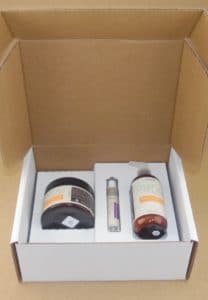Poor Quality Secondary Packaging Hurts Your Business
I’ll put it bluntly but politely – much of the secondary packaging (boxes, tape, etc.) we see from overseas is not very good. People have shared countless stories with us about boxes that smell funny, are weak, thinner than expected, don’t stack well, don’t hold up in shipment, etc. and it matters little where on the globe they are manufactured.
Domestically produced boxes, even boxes like our 100% recycled content Globe Guard® boxes are better and stronger than the majority of corrugated boxes that are used to ship the imported products we all purchase. It is widely accepted that when the US buyer negotiates a lower price with a foreign manufacturer, one of the areas where costs can be most easily reduced is packaging.
Corrugated Boxes Must Be Application Specific
 Imported boxes may not perform well because the board used to make them is substandard. Boxes may be of poor quality, lightweight (thinner than spec), or simply not manufactured well, including bad cuts or poorly glued joints. There can also be esthetic problems such as discoloration, irregular coloring, or even a pungent odor making you wonder what type of materials or chemicals were used. As bad as imported boxes can be, board used for partitions can be even worse.
Imported boxes may not perform well because the board used to make them is substandard. Boxes may be of poor quality, lightweight (thinner than spec), or simply not manufactured well, including bad cuts or poorly glued joints. There can also be esthetic problems such as discoloration, irregular coloring, or even a pungent odor making you wonder what type of materials or chemicals were used. As bad as imported boxes can be, board used for partitions can be even worse.
I can never defend poor-quality materials or manufacturing on imported corrugated board but in the interest of fairness, I also must admit in many cases e-commerce companies are misusing those boxes. The obvious design deficiencies listed above become much more crucial when the box is used for a purpose other than the one it was originally intended for.
In many cases, the domestic customer experiences shipping damage when the cases are shipped individually via USPS, UPS, or FedEx. This is not surprising because the box was minimally designed for bulk shipping on pallets and in ocean freight containers. I am quite confident the manufacturer would be the first to admit his packaging was never intended or designed for the way our client is using it.
A Few “Take With” Points
If you are importing products, we offer these three suggestions:
- Establish specs for your secondary packaging and make it as ecofriendly as possible, especially if you are selling green products to green consumers.
- Ask for samples of the packaging you will be receiving and compare what you were promised with what you receive in shipment.
Last, but not least –
- Make sure your packaging is designed for how you plan to ship the product, NOT for how it is being shipped to you.
We have redesigned, created over packaging, or in some cases made repairs to a lot of imported secondary packaging. Which is the right or best solution for you depends on a lot of factors including what, where, and how many you are shipping.
After reviewing thousands of customers applications, we know there is no “standard” or “average”. Every customer and product are slightly different, but it can be a critical difference if the packaging under performs. Please contact us or call us at 630-551-1700 if you would like a no cost/no obligation review of your specific application.
Related posts:
https://www.salazarpackaging.com/the-cost-of-custom-printed-branded-d2c-packaging/



